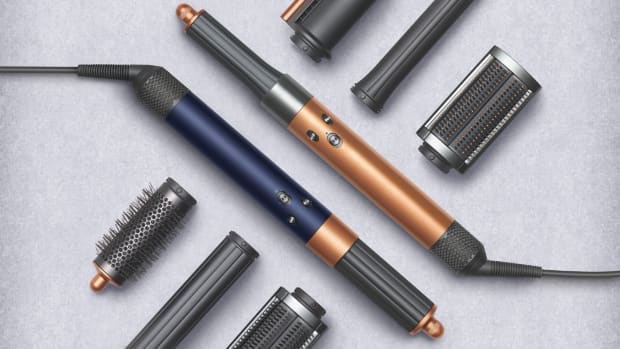Nothing, they say, is certain except death and taxes. Yet across today's fashion landscape, there's a case to be made to embellish Benjamin Franklin's famed proverb with a third matter of
course. And, well, that's Skims.
Now, this may be the first (and also last) time in recorded human history that Kim Kardashian's underwear, loungewear and shapewear brand is mentioned in the same breath as the man said to have discovered electricity. But Skims may just be well on its way to earning the association.
Since Kardashian and her business partner, co-founder and CEO Jens Grede, introduced Skims to the world in 2019, the label has been known to do numbers — in funding, in moving product, in quantifiable customer satisfaction. This January, the company announced it had doubled its valuation to $3.2 billion after raising $240 million in fresh funds from "A" list investors like Thrive Capital and Imaginary Ventures. And while it's not uncommon for venture-backed darlings to overpromise and underdeliver, Skims is angling to do the opposite: Sales are predicted to hit $400 million this year, demonstrating a growth rate that's as compelling as it is increasingly rare. As Grede told Business of Fashion's Alexandra Mondalek in a recent profile, "it took Nike 12 years to reach $100 million; it took us six months."
From an investors' perspective, Skims is the real deal, and perhaps as certain as California's 8.84% corporate tax rate. But with a potential IPO or a seismic acquisition in the cards, it's not just the glossy venture capital sector that's keeping tabs on this new play for "solution-wear."
"I sometimes say that Skims is the closest thing to a sure thing you can get in the space of fashion startups, or emerging brands in the fashion category," says Dulma Altan, the founder and CEO of Makelane, a private community for female founders. "This is, for investors, a rare growth opportunity where it just seems like everything is aligned."
From the outset, Skims had at least two factors working for it immediately, beyond Kardashian's mega-celebrity and Grede's behind-the-scenes strategic experience. The first, naturally, came down to the Skims consumer: young, vocal and invariably online.
In the most general sense, the Kardashian brand appeals to a multigenerational shopper who's fluent in digital culture, explains Thomaï Serdari, adjunct professor of marketing and director of the Fashion & Luxury MBA at New York University's Stern School of Business. The Skims customer uses social media not just to shop and to research, but also to plop opinions all across the internet in the form of streamlined comments and reviews.
"It has been a very active community in response and reaction to the merchandise," says Serdari, "and that, I think, is what helped Skims initially."
There was also the matter of timing. Upon its launch in September 2019, Skims was largely regarded as a shapewear company set on reinventing tired, traditional waist trainers and pasties for the next generation. A slew of tangential categories — including underwear, accessories and as of Friday, swimwear — followed. (Per reporting from Business of Fashion, underwear now makes up a higher percentage of sales than the shapewear with which it entered the market.)
That December, just three months before a mysterious virus began immobilizing the U.S., Skims debuted its first loungewear collection: plush, indulgent house clothes in cozy colors like teddy-bear browns and pearly creams. With the masses stuck at home and left to consider how to maximize their comfort, this is when it all changed.
"The second phase of the company happened to take place during a pandemic," says Serdari. "It was a very specific cultural moment that coincided with how the company came to market. When Skims went into everyday wear, it wasn't just a pivot, but an augmentation of its value proposition."
As with any company, a unique value proposition for the consumer informs the investors' response. What does the company stand for, and how will its goods and services benefit the customer — and by extension, those funding it?
Recommended Articles
"First of all, Skims' inclusivity is obviously the main talking point they try to sell, and that's a really big deal" says Altan, who has built a 52,000-strong TikTok following through her analyses of consumer brands. "They've created so many more shades and sizes than close competitors. In terms of product design, they're filling a need."
Skims' point of difference comes down to sheer scope: Underwear and shapewear come in a healthy range of skin-tones shades, from bone to dark chocolate, and in sizes XXS-5X. Most of all, the customer has come to expect that the wares they purchase actually deliver — a somewhat revolutionary concept in the buy-before-you-try Instagram age.
"Kim reinvented the white tee and jeans for me," says Kirbie Johnson, a beauty reporter and the co-founder of beauty podcast Gloss Angeles, who recently swapped her tried-and-true denim uniform in favor of a Skims bodysuit and sweats. "As a very avid purchaser of the brand, I know when I buy a product, I'm not only going to look great, but the fabric is going to feel good in addition to hugging and accentuating my curves."
According to Business of Fashion, Kardashian herself serves as the brand's fit model, reportedly remaining integrated in the most minute facets of design and execution. "It's safe to say that Skims is [Kardashian]'s baby, whereas KKW Beauty feels a little bit more like an opportunistic venture given the fact that the family is generally involved in cosmetics," says Altan. That Kardahian's star power isn't simply relegated to quarterly press junkets is a big win for investors, too.
Previously, Grede has been tight-lipped about the financial future of the business, telling Bloombergas recently as this past January that the brand had no plans to sell the company or pursue an IPO. That may have changed since: Mondalek’s Business of Fashionprofile quoted Grede as saying an IPO "at some point in the future probably would make sense." Still, the plans are far from concrete — and that's to the brand's benefit.
"At the rate they're growing, I do think that if there are any fashion or direct-to-consumer brands that are good candidates for an IPO, it's Skims," says Altan. "At this point, they're at a $3.2 billion valuation, so that's a pretty hefty price tag for most potential acquirers, and that limits their optionality. One of the few ways they could exit would be to IPO."
Which begs the question: Are there any large, prestigious conglomerates that could stand to acquire Skims in the first place? À la Rihanna's Fenty Beauty, LVMH would be one of the few that would have enough prestige, and also enough capital, to finance that kind of an acquisition. Altan adds that a sale to a strongly-aligned partner could be better for the long-term prospect of the company.
Even on the other side of a sale, Johnson, for one, doesn't foresee Kardashian throwing in the proverbial bouclé towel anytime soon. The playbook here already exists: In January 2020, Kylie Jenner sold 51% of her Kylie Cosmetics empire to beauty giant Coty in a (now-inflated) deal valued at $1.2 billion. Rest assured for Skims loyalists, the brand's runway is long — longer than Kylie Cosmetics', even, and already more financially lucrative. In the mad dash to entrepreneurial cash-outs, not all companies need to end up on Wall Street to reach optimal success.
"Knowing who the investors are behind Skims, these are firms that have taken startups to a very long trajectory," says Serdari. Take Thrive Capital and Imaginary Ventures, both of which flaunt deep-pocketed portfolio companies like Affirm, Farfetch, Glossier, Slack and Spotify, some of which have gone public. "My gut feeling is that this is definitely a company that targets growth, but I don't think that growth is going to come through an IPO — not now."
There's still room for expansion, after all, and this is exactly what investors want. Johnson expects to see Skims athletic gear and footwear in the near future; permanent brick-and-mortar locations are "absolutely a goal sooner rather than later," Kardashian told Business of Fashion. (Currently, the brand hosts exclusive partnerships with select global retailers, including Nordstrom, Selfridges and Galeries Lafayette.) Another possibility may be to extend Skims into beauty, keeping the entity separate from that of KKW Beauty, 20% of which was sold to Coty in 2021. "Skims Care has a good ring to it," says Johnson.
Still, Skims isn't exempt from the pressures that afflict any burgeoning stalwart, even those that today may feel like a sure thing. Because just as investors will race to prop you up, flood you with funds and shield you from failure, they'll also be there to collect their returns.
"With venture-backed brands that are very fast-growing, people tend to have this assumption that this rate of growth is going to continue indefinitely, and that's tricky," says Altan. "It's difficult to sustain for any brand, even if it's backed by the biggest celebrity in the world."
Never miss the latest fashion industry news. Sign up for the Fashionista daily newsletter.



